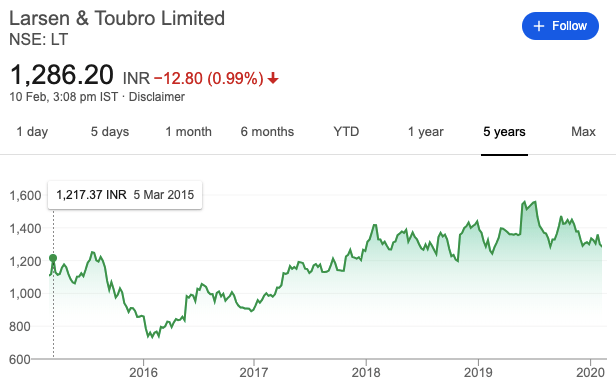There are two types of corrections in the stock market – price correction and time correction.
Price correction is fall in the price of a share. If you invest ₹ 100 in a stock and the price falls to ₹ 90, it’s called price correction.
But what if you invest ₹ 100 in a stock and even after 2-3 years of your investment, the price remains somewhere around ₹ 100? You do not have any losses to show, but you do not have any gains either.
This side ways movement of price, without any major gain or loss, is called time correction.
Example of Time Correction
The chart below is of Larsen and Toubro (L&T), the biggest infrastructure company in India. The stock has under-performed in the last few years.
If an investor invested ₹ 1 lakh in L&T exactly 5 years ago in March 2015, his returns today would be close to zero.
The share price was around 1250 back then, it’s around the same now.

This stagnation in stock price, when combined with steady growth in business, makes the stock cheaper – giving investors more value for the price they are paying.
The Price-to-earning ratio (PE) of L&T in March 2015 was 30. In February 2020, the PE is less than 19. In other words, the stock is cheaper today as compared to 5 years ago.
Opportunity Cost
When a stock under-performs for a long period time, there is something called ‘opportunity cost’ – which many new investors do not understand.
In simple words, ‘Opportunity cost’ means, if the investor had understood that his investment in L&T was stagnating and had shifted his investment to Bajaj Finance. His returns would be phenomenal.
Bajaj Finance has gone from 450 rupees per share to 4500 rupees per share in 5 years. Whereas the price of L&T has remained the same.
The L&T and Bajaj Finance example is given with the benefit of hindsight. Taking the right decisions at the right time isn’t easy in the stock market. The future of any business is difficult to predict and the future movement of the stock price is almost impossible to predict.
During the same 5 years, India’s top pharma company ‘Sun Pharma’ has gone from ₹ 1,000 per share to ₹ 400 per share today. 60% loss in a top company in 5 years.
If an investor moved from L&T to Sun Pharma, the losses would’ve been huge. If he stayed invested in L&T, his only gain would be the dividends that the company has paid – which is less than inflation.
Again, the stock market is an unpredictable place. If the price of L&T doubles by the end of this year, the investor who has stayed invested for 5-6 years wouldn’t regret his decision.
Staying invested in good companies which are undergoing price correction, may not necessarily be a bad idea.
It can turn out be a good decision eventually and also give the investor invaluable lessons on patience.


AADHAR CARD